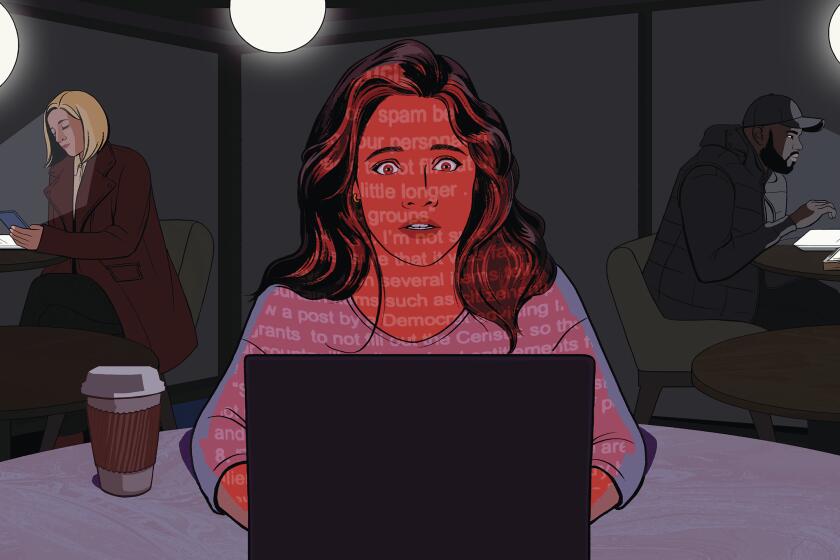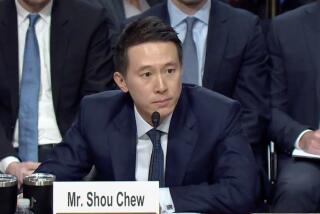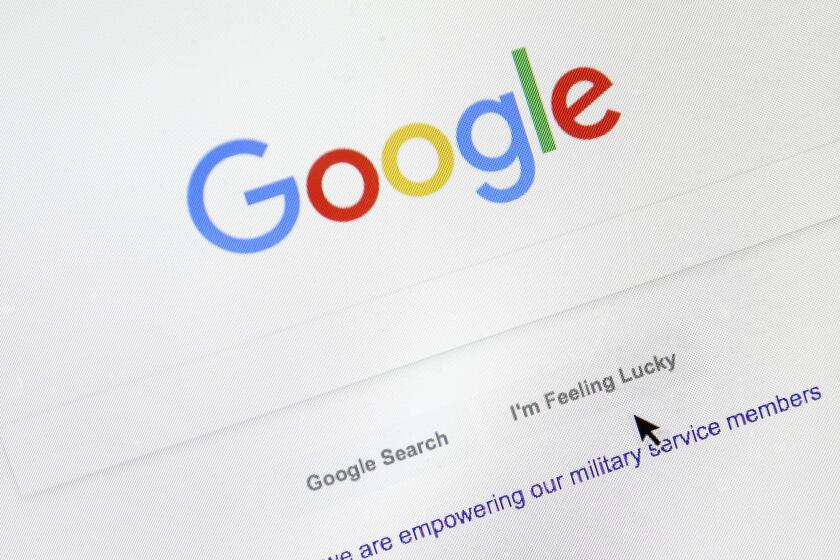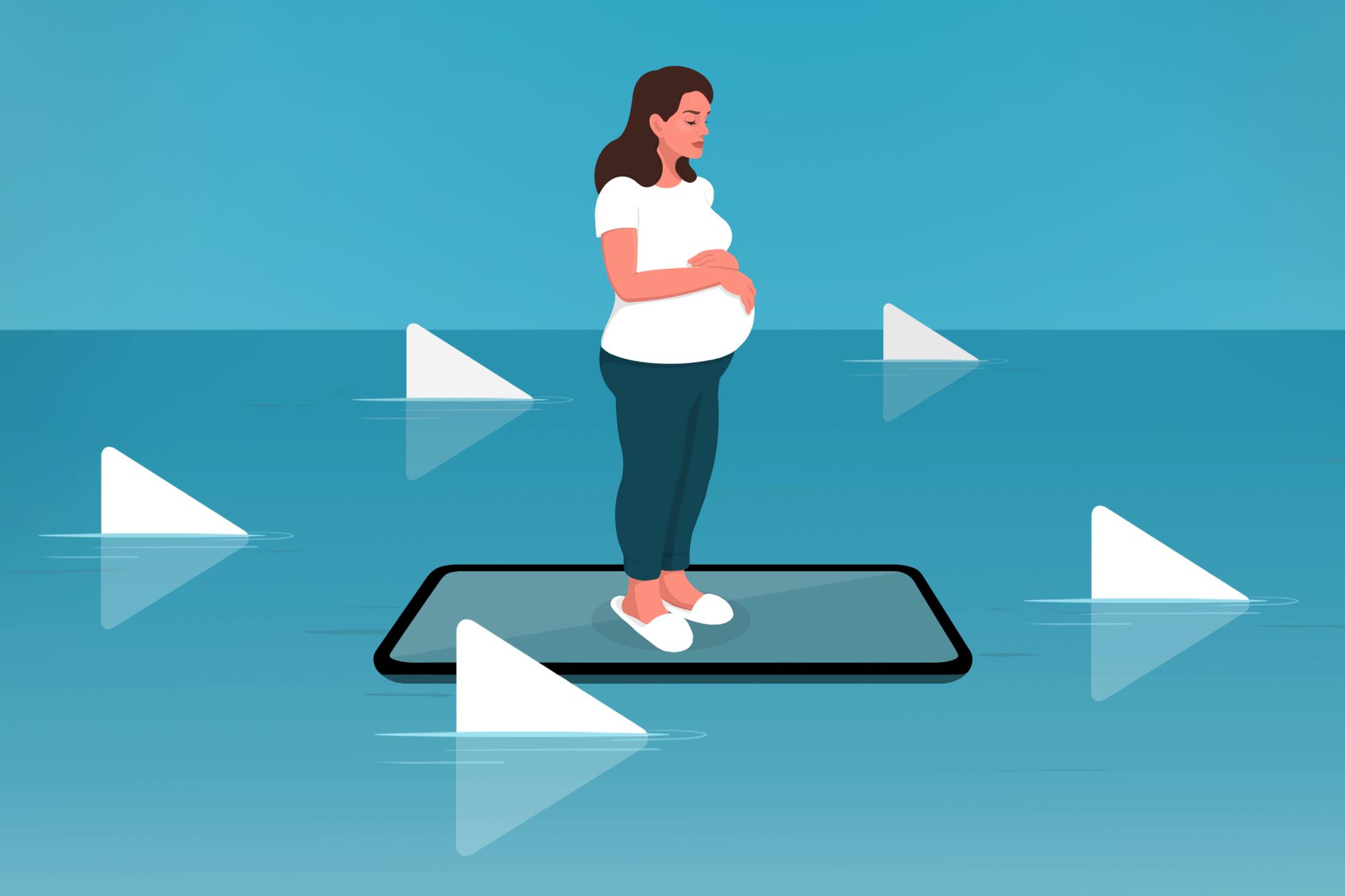
Sensitive content warning
This article discusses topics that may be upsetting to expectant or bereaved parents or to other readers. It also includes embedded social media videos discussing those topics.
When Adriana Lopez found out that she was pregnant, one of the first places she turned was TikTok.
Immediately, she began to search for posts about morning sickness and other side effects, Lopez recalls. This was the Stockton resident’s first pregnancy, and she wanted to be prepared.
But the app soon began pushing her in a direction that made her uncomfortable. During her first trimester, she said, her “For You” page — the TikTok feed where the app’s seemingly psychic algorithm curates an ever-more-personalized stream of videos — filled up with videos about miscarriages. By her second trimester, it had switched over to clips about genetic disorders and stillbirths.
“They start it with pictures of the baby, and really sweet content, that gets you to watch,” Lopez, now 31, said in direct messages. “And then towards the end of the video, it reveals that [the] baby was stillborn.”
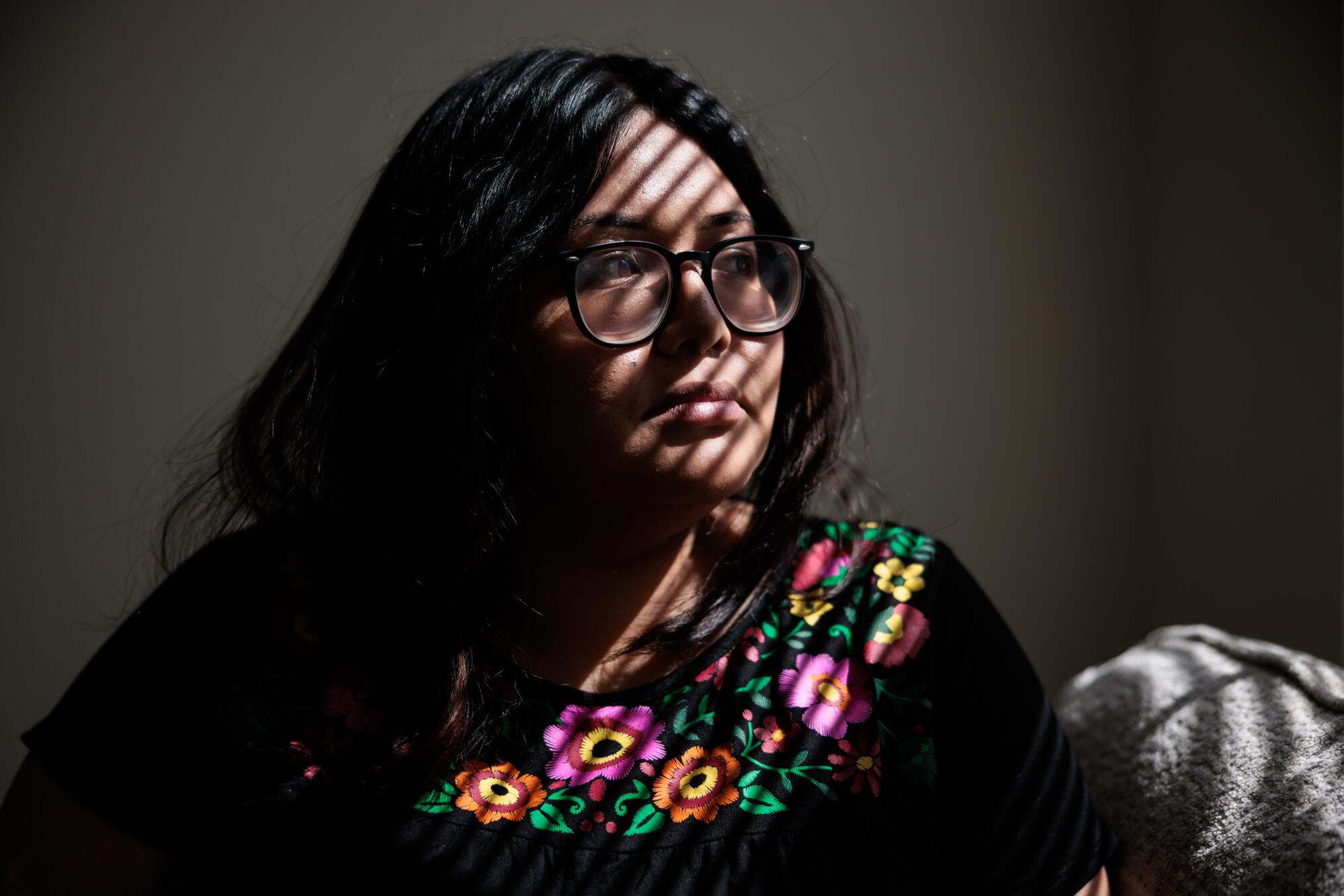
She began to feel paranoid that something would go wrong with her own pregnancy. She tried to use the app’s “Not interested” button to signal that she didn’t want to see any more alarming pregnancy videos, but they kept appearing in her feed; she estimates that by her third trimester, they made up more than half of all the videos that TikTok was showing her. Three of her friends, all of them also pregnant for the first time, told her they were dealing with the same thing.
They weren’t alone. Across the country and around the world, pregnant women are finding themselves pummeled on social media with video after video about the most terrifying aspects of pregnancy.
One woman said she found her Instagram account inundated with posts about birth defects and chromosomal abnormalities.
Another said she kept getting shown “intrusive” YouTube videos about miscarriages.

A third said Facebook has been getting “a little crazy” as she nears her delivery date; it seems to want her to watch videos about the risk of dying in childbirth.
The Times interviewed 13 women, received statements from nine more and reviewed social media posts written by 62 others who’ve all struggled with some version of this problem. A few were able to filter the unwanted content from their feeds by conscientiously adjusting their viewing habits or making use of in-app safety features; many had to choose between abstaining from social media and seeing these videos until they had their babies.
Although other apps also seem susceptible to this problem, the women whom The Times spoke with overwhelmingly cited three specific social media channels as responsible for their anxiety: TikTok’s “For You” feed; Instagram’s TikTok copycat Reels; and Instagram’s Explore page.
Notably, all three rely heavily on algorithms to pick which posts to show users. Although other major platforms such as Twitter, Facebook and Reddit encourage users to curate their feeds in different ways, TikTok, Reels and Explore operate on a more passive model, using behavioral data to round up content users might never have sought out for themselves. Machines, the subtext seems to be, understand what we want better than we do ourselves.
The experience that Lopez and so many other expectant mothers reported — being identified as pregnant by their online behavior, without having explicitly volunteered that information, and then getting targeted with content focused on the last things that expectant mothers want to be thinking about — may be what happens when that self-driving system runs off the road.

Subscribers get exclusive access to this story
We’re offering L.A. Times subscribers special access to our best journalism. Thank you for your support.
Explore more Subscriber Exclusive content.
Even under the best of circumstances, pregnancy can be a vulnerable time. Parijat Deshpande, the author of “Pregnancy Brain: A Mind-Body Approach to Stress Management During a High-Risk Pregnancy,” said in an interview that pregnancy changes a woman’s hormonal and immunological profile in ways that can increase the risk of stress.
Although postpartum depression is better known, it’s also common for women to get depressed during a pregnancy, said Vivette Glover, a professor of perinatal psychobiology at Imperial College London. Anxiety and depression each affect about 15% of women around the time of their delivery date, she said, “and they’re equally common in pregnancy and postnatally.”
Pregnant women are also a uniquely lucrative demographic for web platforms to court, with the arrival of a baby bringing new spending on all manner of products — binkies, nursery monitors and more. That makes them a prime target for third-party ads.
Why, then, do these systems serve pregnant users so much content they say they hate? Though the algorithms themselves are largely black boxes, the incentives that guide their parent companies are clear enough: an attention economy built to keep users engaged and online.

“The reality is, people are drawn to extreme content,” said Frances Haugen, the Facebook product manager-turned-whistleblower who last fall helped reveal the extent to which Mark Zuckerberg’s company has been aware of its negative social effects.
For social media companies, catering to users’ “revealed” preferences — i.e. their behavior — rather than their “expressed” or stated preferences often produces more monetizable engagement in the form of time spent, likes and comments.
Users “don’t want to necessarily watch babies dying or miscarriages or whatever,” said Haugen, who has worked on content-ranking algorithms at Facebook and other platforms. “But [it’s a] ‘You can’t avert your eyes’ kind of thing.”
Down the rabbit hole
All Kelsey Versteeg wanted to see were cute animals.

She’d been struggling with insomnia during her pregnancy and would find herself up in the middle of the night watching Reels about foster pets. But somehow, the app had also figured out that the 39-year-old Oakland resident was going to have a baby soon, and so it began pushing her video after video about pregnancies.
If Roe vs. Wade is overturned, personal data collected via the internet could become evidence of criminal intent if women seek an abortion.
Some of the posts, though not really her thing, were inoffensive enough — videos about gender reveal parties or families with twins and triplets, she said. But a lot of them were what she took to calling “bleak baby content.” As with Lopez on TikTok, Instagram had started steering Versteeg toward stories about stillbirths, extremely premature babies and babies with severe health problems.
“Reels would always start with the cat and puppy stuff that I actually wanted to see, and then this would be pushed into my feed,” she said. “I’d try to swipe it away so I wouldn’t see it, but it seemed like they really tried to push that in.”
The fetal scans and blood tests that pregnant women have to do all the time are stressful enough, Versteeg said, without also constantly absorbing other women’s medical trauma online. But it was hard to avoid the clips, she said; many of them started off innocuous, only to pivot toward tragedy at the end. They made her anxious.

Versteeg wasn’t searching for this content, she said, and didn’t follow any accounts focused on it. She even tried swiping past everything that seemed remotely baby-related. Still, the nightmarish content spewed forth.
“I think when you are pregnant you are curious what could go wrong,” she said. “But it just seems so unhealthy to lead someone down that path.”
“It can be very scary as a pregnant woman to be getting all this negative information and all this almost fear-mongering stuff,” said Kayla LaTour, 23, who is a little over seven months along in her first pregnancy.
LaTour is careful not to “like” the videos about stillbirths, miscarriages and delivery trauma that now fill her feed, or to follow the people who make them. Still, she sometimes finds herself watching them when they pop up.
“They have this way of hooking you in so you watch the whole thing,” she said. “At the back of your head you’re like, ‘Oh, this woman had low risks for everything and her baby still came out with severe birth defects’ or ‘Her baby was stillborn.’ And you get scared; like, ‘Oh, God, what if that’s gonna happen to me?’ ”
By responding to the videos this way, she probably is encouraging the app to show her more of them — even though she hates seeing them.
Haugen, the whistleblower, said that the time someone spends watching a video is one of the factors TikTok uses to decide what else to show them. The company has also said that recommendations are based on signals such as a user’s likes and comments; leaked documents indicate that time spent on-app and user retention are key metrics for the company.
Facebook has long emphasized the strength of its efforts to contain misinformation targeted at Latinos and Spanish speakers. A whistleblower’s leaks show employees raising alarms about the problem.
Meanwhile, Instagram says that its Explore algorithm considers what previous posts a user has liked, saved or responded to in order to offer new content they’re likely to further engage with; and that Reels is “specifically focused on what might entertain” someone, as predicted based on factors such as what posts they’ve previously engaged with and how popular a given content creator is.
That these signals seem able to so easily figure out when a woman is pregnant could come to bear outsize importance if the Supreme Court overturns Roe vs. Wade, as it seems poised to do. If a woman’s online data indicate she’s pregnant but she never gives birth, the New York Times’ Zeynep Tufekci recently noted, it could mark her as a target for investigation in the many states where abortion may soon become illegal.
A TikTok spokesperson told The Times that the platform doesn’t track users’ pregnancy status. In a blog post in December, the company wrote that it was “working to recognize if our system may inadvertently be recommending only very limited types of content that, though not violative of our policies, could have a negative effect,” such as content about weight loss or loneliness.
A spokesperson for Meta, the parent company of both Facebook and Instagram, said in an email that “parents use Instagram to get advice, share their experiences, and seek support from other parents, including when their children have special needs. Our recommendations allow people in this community to find one another, but they can always let us know in the app if they’re not interested in something recommended to them.”
The company also supports regulation that would set clear industry standards on this topic, the spokesperson said.
Sounding the alarm
In 2015, Ana Vick’s son Owen was stillborn. It was a tragedy that would change the course of her life forever.

The loss prompted Vick to get involved with stillbirth prevention advocacy in hopes that she could spare other mothers the grief she experienced. Last year, she helped found the nonprofit advocacy group Push for Empowered Pregnancy, which aims to end preventable stillbirths; more recently she got involved with Count the Kicks, a group focused on raising awareness about how tracking fetal movements can help prevent stillbirths.
But for many pregnant women, Vick is recognizable less as a behind-the-scenes activist than as a social media influencer — albeit a very niche one. Posting on TikTok and Instagram under the handle “Still My Son,” Vick makes videos about her advocacy work, what it was like to lose a child and how viewers can avoid stillbirths of their own.
“Many of us don’t even know the word ‘stillbirth’ until it happens to us,” Vick said. “It’s very important for me … to make sure that these mothers feel like they know that it’s not their fault and they’re not alone.”
In one such TikTok — captioned “Pregnancy advice I wish I was given before our son was unexpectedly #stillborn & our whole world was shattered” — Vick encourages pregnant women to track the pattern of their baby’s kicks and, if anything seems amiss, seek medical help. “You don’t want to have any regrets that you didn’t know that your baby was in distress,” Vick warns her viewers. “Please keep your baby safe.”
The video has been seen more than 337,000 times. Among those viewers was Lopez; like so many other such videos, it had popped up in her TikTok feed.
Videos such as Vick’s kept Lopez up at night worrying about her unborn child. “I couldn’t sleep thinking something was wrong,” she said. “Especially during daytime, I would shake my belly multiple times because I thought [my] baby wasn’t moving.” They even convinced her to buy her own fetal Doppler, which experts and the Food and Drug Administration advise against.
The argument that these videos are less educational than anxiety-inducing is one Vick has heard plenty of times before — and finds unconvincing. Below her TikToks, women sometimes comment that the app is scaring them or that they don’t want to keep getting shown stillbirth videos while going through their own pregnancy. “I’m sorry for your loss! But this makes a lot of parents anxious!!!” one woman wrote under the same video Lopez saw. “I understand awareness but it’s very overwhelming! I really dislike these videos.”
Vick thinks that’s an acceptable price to pay for spreading the word about stillbirths.
“Unfortunately, yes, it might cause [parents] to be a little bit worried or anxious,” she said — but women who’ve lost a child “would have rather known and been able to fight for our child than to not know and be blindsided.”
“You cannot have a stillbirth by seeing a stillbirth,” she said. “It’s not contagious.”

Allie Felker, another Push for Empowered Pregnancy volunteer who makes TikToks about her own experience with stillbirth and stillbirth advocacy, agreed.
“One of the main things I’m told is that I’m fear-mongering,” Felker said. “And to that I just say: We’re strong. We deal with really painful, difficult things all the time.
“I do not want pregnant women to feel anxious; I felt anxious throughout an entire pregnancy. But I really believe that if you’re informed, that actually can take away from anxiety.”
Yet even if women like Vick and Felker think it’s important to make this kind of content, that ethos has its limits.
After her stillbirth, Vick says, she spent some time off social media; she found it too triggering.
“I was already afraid enough,” she said. “I didn’t need to know more ways that my next child could die.”
Looking for alternatives
For some women, the only way to escape these videos seems to be to log off.
Sarah Zeilinger, a first-time mother in Austria, said that once Instagram switched from showing her “innocent” Reels about pregnancy to ones that instead focused on stillbirths, miscarriages and infant death, she deleted the app.

The artificial intelligence models used to target content are persistent, and starting over with a fresh account is the only way to be completely free of recommendations based on past behavior, Haugen, the whistleblower, said. But that shouldn’t be necessary, she said: “We should have the ability to be able to say, ‘I don’t want this to follow me anymore.’ ”
LaTour said she wished TikTok more consistently put content warnings on disturbing pregnancy videos. The app does have a mechanism for blurring out sensitive content and requiring that viewers click through before seeing it, but she said she’s never seen that feature applied to a pregnancy post. The Times found some such posts that did, however.
Several other women said that they’d like to see trigger warnings used more frequently to mark this content as potentially distressing. (Vick pushed back on that when it comes to stillbirth videos: “Any loss parent would say no trigger warning is needed for our children.”)
Influencers can find fame and fortune on TikTok — but only if their videos stay up. Communities of online trolls and coders say they have tools to keep that from happening.
And two women suggested that apps add “Click here for more information” buttons below pregnancy-related posts to put things in medically verified context, similar to how platforms have promoted COVID-19 research during the pandemic.
Brooke Koines, 33, of Torrance, who’s pregnant with her second child, said that she started seeing stillbirth and birth defect TikToks almost immediately after finding out she was going to have another baby. But as with a handful of women The Times heard from, she proactively started marking herself as not interested in those videos, and within a week they had largely left her feed.

“I think TikTok should be giving those tips and tricks to its users,” Koines said, rather than leaving it up to them to educate one another — as another TikToker did for her.
(Lopez and LaTour said that TikTok’s “Not interested” button has had no clear effect on the types of videos they are shown. Other women reported having the same problem with the equivalent Instagram feature.)
TikTok does offer a “Restricted Mode” that cuts out posts “that may not be appropriate for all audiences,” but that tool doesn’t allow for finer-grained blocking. The company also says it’s developing a feature that would let users block specific words or hashtags: for instance, #stillbirth. Instagram is in “the very early stages of exploring” a similar tool, a spokesperson said.
But some people are skeptical that these apps can be reformed.
Michelle Kennedy, founder and chief executive of the women’s social network Peanut, said that her app doesn’t shy away from hosting conversations about the sensitive, even “gory,” parts of womanhood. But because pregnancy is central to the app’s design — users are categorized as either trying to conceive, pregnant, mothers or menopausal — and because Peanut doesn’t optimize for time spent as a metric, those conversations tend to go over better, she said.
“The internet [as a whole] is trying to sell to women; polarize women; polarize thought; create bubbles; create doom-scroll,” Kennedy said. “I can say to you, ‘Wouldn’t it be great if other networks did what we did?’ But they won’t … because the ad dollar is very important; because the longer you spend, the more likely it is that you’re gonna see a Pampers advert.”
For Lopez, at least, the problem ended up resolving itself. On Feb. 8, she gave birth to a healthy baby girl. Not long after, the anxiety-inducing pregnancy TikToks started to disappear.
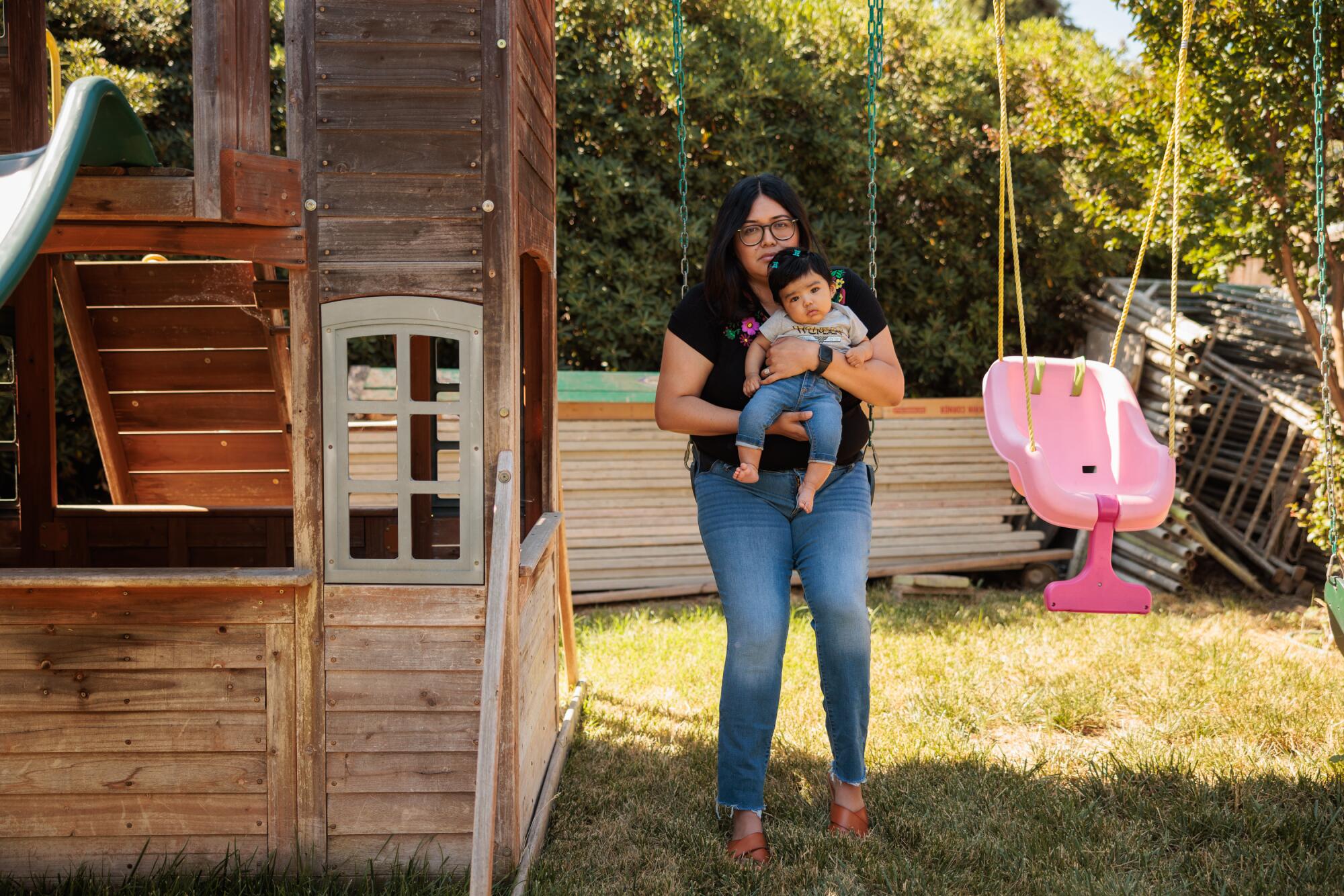
But with motherhood came a new threat. In the place of stillbirth videos, Lopez said, her feed instead now pushes ones about sudden infant death syndrome.
“First, I was scared that my baby was gonna die in my stomach,” she said. “Now I’m scared my baby’s gonna die in the crib.”
More to Read
Subscriber Exclusive Alert
If you're an L.A. Times subscriber, you can sign up to get alerts about early or entirely exclusive content.
You may occasionally receive promotional content from the Los Angeles Times.

